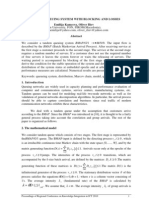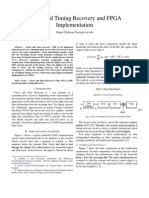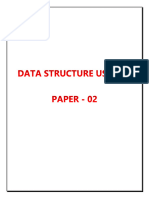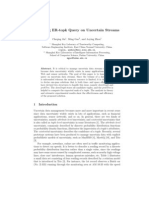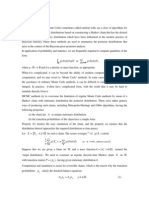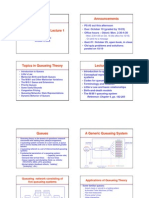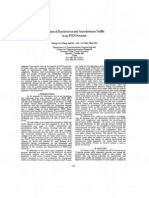ISORA2008F07
ISORA2008F07
Uploaded by
carboneze9706Copyright:
Available Formats
ISORA2008F07
ISORA2008F07
Uploaded by
carboneze9706Copyright
Available Formats
Share this document
Did you find this document useful?
Is this content inappropriate?
Copyright:
Available Formats
ISORA2008F07
ISORA2008F07
Uploaded by
carboneze9706Copyright:
Available Formats
The 7th International Symposium on Operations Research and Its Applications (ISORA08) Lijiang, China, October 31Novemver 3, 2008
Copyright 2008 ORSC & APORC, pp. 6065
The monitoring of the network trafc based on queuing theory
Wang Jian-Ping1,
1 School ,
Huang Yong1,
of Information Engineer, Henan Institute of Science and Technology, Xinxiang, 453003, china
Abstract Network trafc monitoring is an important way for network performance analysis and monitor. The article explains how to build the basic model of network trafc analysis based on Queuing Theory, using this, we can obtain the network trafc forecasting ways and the stable congestion rate formula, combining the general network trafc monitor parameters, we can realize the estimation and monition process for the network trafc rationally. Keywords Queuing Theory; M/M/1 queue; trafc monitor; congestion rate; Markov Process
1 Foreword
Queuing Theory, also called random service theory, is a branch of Operation Research in Maths, its a subject which researches the random regulation of queuing phenomenon, and builds up the maths model by analyzing the date of the network. Through the prediction of the system, we can reveal the regulation about the queuing probability and choose the optimal method for the system. Adopting Queuing Theory to estimate the network trafc, which becomes the important ways of network performance prediction, analysis and estimation, through this way, we can imitate the true network, its useful and reliable for organizing, monitoring and defending the network.
2 The maths model of the Queuing theory
the proIn network communication, from sending, transferring to receiving data cn ceeding of the data coding, decoding and sending to the higher layer, With all these process ,we can nd a simple queuing model. According to the Queuing Theory, this correspond procedure can be abstracted as Queuing theory model [9], like gure 1 showing to us. Supposing this kind of simple data transmitting system satises the queue model M/M/1[5].
by the natural science foundation of Education Department of Henan province grant NO. 2007520017 He was born in 1981, in BaoJi, ShaanXi province of china, he is a master candidate, his research area is Computer Network and Operation Research. He was born in 1970, in ChangSha, Hunan province of China, he is a lecturer, his research area is Computer Graphics and Computer Software.
Supported
The Monitoring of the Network Trafc based on Queuing Theory
61
Figure 1: The abstract model of communication process From the gure above, stands for the sending rate of the sender, TN is regarded as transportation delay time , means the arriving speed of the data packets,Nq is the quantity of data packets stored in the buffer, is the lost rate of the receiver ,and TS = TJ + TD + TC is the service time of data packets in the queue. TJ , TD and TC stand for the decoding, dispatching and handling time separately. The sender is abstracted to be a queue, whose sending rate is . In model M/M/1, the two M represent the sending process of the sender and the receiving process of the receiver separately. They both follow the Markov Process[2], also keep to Poisson Distribution, while the number 1 stands for the channel. Using N(t)=t as the length of the queue at the moment of t, so the probability of the queue whose length is n ,can be shown as the following formula . pn (t ) = p[N (t ) = n] According to the formula 1,we can know the equation 2: pn (t ) = pn1 (t ) + pn+1 (t ) ( + ) pn (t ), n = 0, 1, 2 . . . p0 (t ) = p1 (t ) p0 (t ) (2) (1)
In equation 2, supposing as the arrival rate while as the service rate, when t , we can get the stable solution of the equation pn (t ). pn (t ) = (1 )n = 0, 1, 2, . . . (3)
In formula 3, using = / 1 as the probability of the service. N stands for the length of the queue under the balanced condition, It includes the average volume of all the data packets which enter the processing module and store in the buffer. N=
n=0
npn = pn (1 ) = 1
n=0
(4)
If Nq shows the average volume of the buffers data packets, We can conclude the following formula Nq = N =
2 = 1 1
(5)
If the processing module is regarded as a closed region, the parameter is brought into the formula 5,using the Little Law, we can get the equation(6)
62
The 7th International Symposium on Operations Research and Its Applications
= TS =
(6)
After putting equation (6) into the equation (5) and sorting it out, we can get the formula(7) ( Ts )2 + TS Nq Nq = 0 (7)
According to the derivative formula (7), we make a conclusion, among three variables, the service time ,the sending rate, and the buffer, if we know any two variables ,it is easy to gain the numerical value of the third one .So these three variables are the key parameters for measuring the performance of the transmission system.
3 Queuing theory and the network trafc monitor
3.1 The method of monitoring the network trafc
Trafc monitoring is the basic way for scheduling, concerting and operating the net[7]. Network usually uses Peak Information Rate(PIR),Peak Burst Length(PBL),Commitment Information Rate(CIR),Commitment Burst Length(CBL),Extra Information Rate(EIR)and Extra Burst Length(EBL),the six parameters as the network trafc monitoring parameters. Using the six parameters above, we can realize two kinds of Bandwidth Measurement Algorithms, they are PIR/CIR Algorithms and CIR/EIR Algorithms[8], PIR/CIR uses four parameters, they are PIR ,PBL,CIR and CBL.CIR/EIR also uses four parameters, they are CIR,CBL, EIR and EBL. In these algorithms, each of the PIR/PBL,CIR/CBL, EIR/EBL informs a Token Bucket partly[6] ,from this we know that every algorithms contains two token buckets, so they are called dual-token buckets algorithms.
3.2 Forecasting the network trafc using Queuing Theory
The network trafc is very common[4], Whats worse, when the trafc becomes under extreme situation, it will lead to the nets paralysis[1]. There are a great deal of research about monitoring the congestion at present ,besides, the documents which make use of Queuing Theory to research the trafc rate appear more and more. for forecasting the trafc rate, we often test the data disposal function of the router used in the network. Supposing a routers arrival rate of data ow in groups is , and the average time 1 which the routers use to dispose each group is , the buffer of the routers is C, if a certain group arrives, the waiting length of the queue in groups has already reached, so the group has to be lost. When the arriving time of group timeouts, the group has to 1 resend, Supposing the groups average waiting time is , we identify pi (t ) to be the arrival probability of the queue length for the routers group at the moment of t , supposing the queue length is i: p(t ) = ( p0 (t ), p1 (t ), . . . , pn1 (t )), i = 0, 1, . . . , C + 1 (8)
Then the queuing system of the routers date groups satises simple Markov Process[10], according to Markov Process, we can make the diversion strength of matrix as follow:
The Monitoring of the Network Trafc based on Queuing Theory
Q=
63
( + + )
+ ( + + 2 )
+ 2 . . .
...
( + + C )
+ C (9)
3.3 Network Congestion Rate
Network congestion rate is changing all the time [3], the instantaneous congestion rate and the stable congestion rate are often used to analysis the network trafc in network monitor. The instantaneous rate AC (t ) is the congestion rate at the moment of t .The AC (t ) can be obtained by solving the system length of the queues probability distributing, which called pn1 (t ).According to some properties of Markov Process, we know that pi (t )(i = 0, . . . , C + 1)satises the following differential equation systems: p (t ) p0 (t ) + p1 (t ) 0 p (t ) = [ + (k 1) ] pk1 (t ) [ + + k ] pk (t ) + pk+1(t ), k = 1, . . . , C PC+1 (t ) = [ + C ] pC (t ) pC+1 (t ) p0 (0) = 1, p2 (0) = p3 (0) = . . . = pC+1(0)=0
(10)
By solving this differential equation systems, we get the instantaneous congestion rate A0 (t ) is
(11) (1 e( + )t ) + The instantaneous congestion rate cant be used to measure the stable operating condition of the system, so we must obtain the stable congestion rate of the system. The so-called stable congestion rate means it will not change with the time changing, when the system works in a stable operating condition. The denition of the stable congestion rate is
A0 (t ) = P1 (t ) = AC (t ) = lim AC (t )
t
(12)
Supposing = lim p(t ) as the distributing of the stable length of the queue, C as t the buffer of the router, the stable congestion rate can be obtained in two ways: rstly, we obtain the instantaneous congestion rate ,then make its limit out . According to its denition, it can be obtained with the distributing of the length of the queue. Secondly, according to the Markov Process, we know that the distributing of the stable length of queue can be get through evaluating equation (13) pQ = 0 (13) C+1 Pi = 1
i=n
64
The 7th International Symposium on Operations Research and Its Applications
In the equation p = ( p0 , p1 , . . . , pC+1 ), When C=0, the equation (13)s evaluation is A0 = P1 +
(14)
When C=1, the equation (13)s evaluation is A1 = P2 =
( + ) ( + ) + ( + )
(15)
When C =2, the equation (13)s evaluation is A3 = P4 = 1
( + + 2 )A2 ( + )(1 A1 )A0 +
(16)
on the analogy of this , we conclude that ,the stable congestion rate is
AC = PC+1 = 1
( + + C )AC1 ( + (C 1) (1 Ac1 )AC1 +
(17)
4 Conclusion
The article explains how to build the queue model based on the Queuing Theory, how to realize calculation and analyzing the network trafc through M/M/1 Queuing Theory, and then gets the forecast way and the formula of the stable congestion rate of the network trafc. The network trafc monitoring model which is tested , experimented and analyzed by the actually system ,shows that using the Queuing Theory will optimize the network trafc, its convenient and simple for calculating and monitoring the network trafc properly.
References
[1] Wang Ting, Wang Yu. Survey on a Queue Theory Based Handover Scheme for UAVS Communication Network. Chinese Journal of Sensors and Actuators, 2007, 04 [2] Li Da-Qi, Shen Jun-Yi. Queuing Theory Supervising K-Means Clustering Algorithm and ITS Application in Optimized Design of TTC Network .Journal of Astronautics, 2007, 03 [3] Han Jing, Guo Fang, Shi Jin-Hua. Research on the trafc monitoring of the distributed network based on human immune algorithm. Microcomputer Information, 2007, 18 [4] Wang Pei-Fa, Zhang Shi-wei, Li Jun. The Application and Achievement of SVG in Network Netow Monitor Field. Microelectronics & Computer, 2005, 04 [5] Ren Xiang-Cai, Xiong Qi-Bang. An Application of Mobile Agent for IP Network Trafc Management .Computer Engineering, 2002, 11 [6] Davison B D. A Web Caching Primer. IEEE Internet Computing, 2001, 5(4) [7] Guo Yang, Gong Wei-Bo, Don Towsley. Timestepped Hybrid Simulation (TSHS) for Large Scale Networks. In: Proceedings of IEEE Infocom 2000. Israel: IEEE, 2000
The Monitoring of the Network Trafc based on Queuing Theory
65
[8] Jong Suk Ahn, Peter B Danzig. Packet Network Simulation: Speed up and Accuracy Versus Timing Granularity. IEEE/ACM Trans on Networking, 1996, 4(5) [9] Vern Paxson, Sally Floyd. Why We Don t Know How To Simulate the Internet. In: Proceedings of the 1997 Winter Simulation Conference. USA: ACM, 1997 [10] Gunther N. The Practical Performance Analyst. New York: McGraw-Hill, 1998 [11] ITU-T G.729A. Coding of Speech at 8kbps using Conjugate-Structure Algebraic Code-excited Linear-prediction Coding. USA: ITU-T, 1998
You might also like
- Modeling and Analysis of Urban Traffic Lights Control Systems Using Timed CP-netsDocument16 pagesModeling and Analysis of Urban Traffic Lights Control Systems Using Timed CP-netsHungNo ratings yet
- A Comparison of Active Queue Management Algorithms Using OPNET ModelerDocument8 pagesA Comparison of Active Queue Management Algorithms Using OPNET Modelerdraza81No ratings yet
- Analyzing Poisson Traffic: Lab-Experiment # 04 by Engr. Naveed A. UmraniDocument22 pagesAnalyzing Poisson Traffic: Lab-Experiment # 04 by Engr. Naveed A. UmraniMehboob KhokharNo ratings yet
- AdctestDocument5 pagesAdctestchandu mNo ratings yet
- Analysis of M/M/C Queue Model Under N-Policy: Kumar, Jitendra, Sinde Vikas and Kumar, AvanishDocument6 pagesAnalysis of M/M/C Queue Model Under N-Policy: Kumar, Jitendra, Sinde Vikas and Kumar, AvanishcompmathsjournalwsNo ratings yet
- Sess 6 Tuenbaeva NazarovDocument7 pagesSess 6 Tuenbaeva NazarovParvez KhanNo ratings yet
- Jitter Based Delay Boundary Prediction of Wide-Area NetworksDocument14 pagesJitter Based Delay Boundary Prediction of Wide-Area NetworksebudhyNo ratings yet
- Text Encryption Using ECG SignalsDocument6 pagesText Encryption Using ECG SignalsJyothy SwaroopNo ratings yet
- TPWL IeeeDocument6 pagesTPWL Ieeezhi.han1091No ratings yet
- Carrier and Timing Synchronization of BPSK Via LDPC Code FeedbackDocument5 pagesCarrier and Timing Synchronization of BPSK Via LDPC Code FeedbackJamil AhmadNo ratings yet
- Formal Verification of The Ricart-Agrawala AlgorithmDocument11 pagesFormal Verification of The Ricart-Agrawala AlgorithmShubham ChaurasiaNo ratings yet
- Correspondence: An EM-Based Forward-Backward Kalman Filter For The Estimation of Time-Variant Channels in OFDMDocument7 pagesCorrespondence: An EM-Based Forward-Backward Kalman Filter For The Estimation of Time-Variant Channels in OFDMVijayShindeNo ratings yet
- Neural Networks For Control - 01Document5 pagesNeural Networks For Control - 01Lissete VergaraNo ratings yet
- ) Research Centre For Automatic Control (CRAN UMR 7039) Henri Poincaré University, France) Laboratory of Process Control and Automation, Helsinki University of Technology, Finland E-MailDocument6 pages) Research Centre For Automatic Control (CRAN UMR 7039) Henri Poincaré University, France) Laboratory of Process Control and Automation, Helsinki University of Technology, Finland E-MailHazem GonsulNo ratings yet
- Montepython: Implementing Quantum Monte Carlo Using PythonDocument17 pagesMontepython: Implementing Quantum Monte Carlo Using PythonJuan Bernardo Delgadillo GallardoNo ratings yet
- Systems Methodology and Design IIDocument22 pagesSystems Methodology and Design IIYorghos MenikidisNo ratings yet
- Http://worldconferences - Net - Proceedings of Regional Conference On Knowledge Integration in Information Technology - June 2010 - All ArticlesDocument757 pagesHttp://worldconferences - Net - Proceedings of Regional Conference On Knowledge Integration in Information Technology - June 2010 - All ArticlesKhirulnizam Abd RahmanNo ratings yet
- 1 Integration2010 ProceedingsDocument6 pages1 Integration2010 ProceedingsKhirulnizam Abd RahmanNo ratings yet
- The Gas Concentration Forecast Based On RBF Neural Network and Chaotic SequenceDocument4 pagesThe Gas Concentration Forecast Based On RBF Neural Network and Chaotic SequenceIanmochaNo ratings yet
- Citation Linear Parameter-Varying System Identification of An Industrial Ball Screw SetupDocument7 pagesCitation Linear Parameter-Varying System Identification of An Industrial Ball Screw SetupJessica JaraNo ratings yet
- Modeling and Control of Traffic Flows: SciencedirectDocument7 pagesModeling and Control of Traffic Flows: Sciencedirect1419No ratings yet
- Applsci 09 03606 v2Document14 pagesApplsci 09 03606 v2Jéssica FeitosaNo ratings yet
- Discrete-Time Multiserver Queues With Geometric Service TimesDocument30 pagesDiscrete-Time Multiserver Queues With Geometric Service Timeschege ng'ang'aNo ratings yet
- (ARTICLE) Evaluation of Network Traffic Prediction Based On Neural Networks With Multi-Task Learning and Multiresolution DecompositionDocument8 pages(ARTICLE) Evaluation of Network Traffic Prediction Based On Neural Networks With Multi-Task Learning and Multiresolution DecompositionMaria RojasNo ratings yet
- All Digital Timing Recovery and FPGA Implementation: Daniel Cárdenas, Germán ArévaloDocument6 pagesAll Digital Timing Recovery and FPGA Implementation: Daniel Cárdenas, Germán Arévalom0hmdNo ratings yet
- Final Year Project On Petri Net ModelDocument34 pagesFinal Year Project On Petri Net ModelRishiraj SenguptaNo ratings yet
- Intelligent Simulation of Multibody Dynamics: Space-State and Descriptor Methods in Sequential and Parallel Computing EnvironmentsDocument19 pagesIntelligent Simulation of Multibody Dynamics: Space-State and Descriptor Methods in Sequential and Parallel Computing EnvironmentsChernet TugeNo ratings yet
- A High Estimated Accuracy Random Access Preamble Detection Algorithm For FDD-LTE SystemDocument8 pagesA High Estimated Accuracy Random Access Preamble Detection Algorithm For FDD-LTE Systemevil_dragonNo ratings yet
- Project Report: Queuing of Network PacketsDocument13 pagesProject Report: Queuing of Network Packetsrocks271089No ratings yet
- Applications of Adjoint TheoryDocument18 pagesApplications of Adjoint TheoryaliNo ratings yet
- Algorithms For Planning S-CurveDocument8 pagesAlgorithms For Planning S-Curvebeemer03No ratings yet
- Geo/Geo/1/k Interdependent Queueing Model With Controllable Arrival Rates and FeedbackDocument13 pagesGeo/Geo/1/k Interdependent Queueing Model With Controllable Arrival Rates and FeedbackIOSRjournalNo ratings yet
- 231 235 PDFDocument6 pages231 235 PDFanuragsatyarthNo ratings yet
- Clock and Serial Data Communications Channel MeasurementsDocument96 pagesClock and Serial Data Communications Channel MeasurementsKarthik KoneruNo ratings yet
- Trajectory Tracking Error Using PID Control Law For A 2 DOF Helicopter Model Via Adaptive Time-Delay Neural NetworksDocument7 pagesTrajectory Tracking Error Using PID Control Law For A 2 DOF Helicopter Model Via Adaptive Time-Delay Neural Networkspeanuts22No ratings yet
- Articulo Variable Sampling Rate Networked Control SystemsDocument6 pagesArticulo Variable Sampling Rate Networked Control SystemsPaulina MarquezNo ratings yet
- M/M/1 and M/M/M Queueing Systems: 1. Preliminaries 1.1 Kendall's Notation: G/G/N/K QueueDocument12 pagesM/M/1 and M/M/M Queueing Systems: 1. Preliminaries 1.1 Kendall's Notation: G/G/N/K QueueBinesh JoseNo ratings yet
- 1 s2.0 S1474667016322078 MainDocument6 pages1 s2.0 S1474667016322078 MainSamir AhmedNo ratings yet
- Iscas06 Random SamplingDocument4 pagesIscas06 Random SamplingJaswinder Pal BehlNo ratings yet
- Observer Hybrid Systems 4Document12 pagesObserver Hybrid Systems 4Paulina MarquezNo ratings yet
- My HomeworkDocument88 pagesMy Homeworksumit kumarNo ratings yet
- On Algorithms For Planning S-Curve Motion ProfilesDocument8 pagesOn Algorithms For Planning S-Curve Motion Profilessadiqaftab786No ratings yet
- Handling ER-topk Query On Uncertain Streams: (Cqjin, Ayzhou) @sei - Ecnu.edu - CNDocument15 pagesHandling ER-topk Query On Uncertain Streams: (Cqjin, Ayzhou) @sei - Ecnu.edu - CNomegagmNo ratings yet
- MCMC Final EditionDocument17 pagesMCMC Final EditionYou ZhaoNo ratings yet
- A Control Theoretical Approach To Congestion Control of TCP/AQM NetworksDocument6 pagesA Control Theoretical Approach To Congestion Control of TCP/AQM NetworksRajkumar KrishnamurthyNo ratings yet
- Considerations About Establishing Mathematical Models Using System Identification ProceduresDocument4 pagesConsiderations About Establishing Mathematical Models Using System Identification ProceduresioncopaeNo ratings yet
- Oerder Meyer PDFDocument8 pagesOerder Meyer PDFKarthik GowdaNo ratings yet
- Queueing TheoryDocument8 pagesQueueing TheorysamqmulNo ratings yet
- Analysis of Synchronous and A Synchronous Traffic in An FDDI NetworkDocument3 pagesAnalysis of Synchronous and A Synchronous Traffic in An FDDI NetworkArtyom SokolikNo ratings yet
- Fast Computation of Channel-Estimate Based Equalizers in Packet Data TransmissionDocument24 pagesFast Computation of Channel-Estimate Based Equalizers in Packet Data TransmissionSen ZhangNo ratings yet
- Comparative Analysis of Evolutionary Techniques For Relay CoordinationDocument6 pagesComparative Analysis of Evolutionary Techniques For Relay CoordinationMahesh SinghNo ratings yet
- Square-Root Forms of The Minimum Output Energy Detector and EstimatorDocument4 pagesSquare-Root Forms of The Minimum Output Energy Detector and Estimatorsuchi87No ratings yet
- Self-Recovering Equalization and Carrier Tracking in Two-Dimensional Data Communication SystemsDocument9 pagesSelf-Recovering Equalization and Carrier Tracking in Two-Dimensional Data Communication SystemsMANISH KUMARNo ratings yet
- Input Window Size and Neural Network Predictors: XT D FXTXT XT N XT D F T T XDocument8 pagesInput Window Size and Neural Network Predictors: XT D FXTXT XT N XT D F T T Xtamas_orban4546No ratings yet
- A Learning Algorithm For Continually Running Fully Recurrent Neural NetworksDocument10 pagesA Learning Algorithm For Continually Running Fully Recurrent Neural NetworkscabirulNo ratings yet
- Raq: A Robust Active Queue Management Scheme Based On Rate and Queue LengthDocument11 pagesRaq: A Robust Active Queue Management Scheme Based On Rate and Queue Lengthnithya_narmiNo ratings yet
- Schmidt 2019Document30 pagesSchmidt 2019danny alboutrosNo ratings yet
- 55-Polynomial Time PrimalDocument21 pages55-Polynomial Time PrimalttunglNo ratings yet
- Analytical Modeling of Wireless Communication SystemsFrom EverandAnalytical Modeling of Wireless Communication SystemsNo ratings yet
















